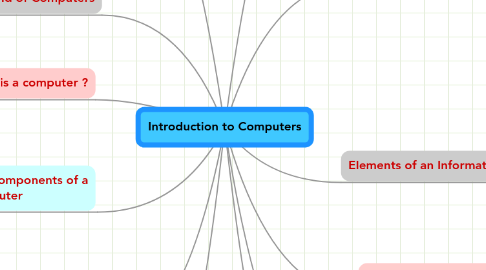
1. What is a computer ?
1.1. A computer is an electronic device, operating under the control of instructions stroed in its own memory
2. A World of Computers
2.1. Computers are everywhere
3. Objectives Overview
3.1. Explain why computer literacy is vital to success in today's world
3.2. Define the term, computer, describe the relationship between data and information
3.3. Describe the five components of a computer
3.4. Discuss the advantages that users experience when working with computers
3.5. Define the term network, and identify benefits of sharing resources on a network
3.6. Discuss the uses of the Internet and World Wide Web
3.7. Distinguish between system software and application software
3.8. Differentiate among types, sizes, andfunctions of computers in each category
3.9. Describethe role of each elementin an information system
3.10. Explain how home users, small office/home office usres, mobile users, power users, and enterprise users each interact with computers
3.11. Discuss how society users compyters in education, finance, government, health care, science, publishing, travel, and manufacturing
4. The Components of a Computer
4.1. A computer contains many electric, electronic, and mechanical components know as hardware
4.1.1. Input Device
4.1.2. Output Device
4.1.3. System Unit
4.1.4. Storage Device
4.1.5. Communications Dvice
5. Advantages and Disadvantages of Using Computers
5.1. Advantages of Using Computers
5.1.1. Speed
5.1.2. Reliability
5.1.3. Consistency
5.1.4. Storaeg
5.1.5. Communications
5.2. Disadvantages of Using Computers
5.2.1. Health Risks
5.2.2. Violation of Privacy
5.2.3. Public Safety
5.2.4. Impact on Libor Force
5.2.5. Impact on Environment
6. Networks and the Internet
6.1. A network is a collection of computers and device connected together, often wirelessly, via communications device and transmission media
6.2. The Internet is a worldwide collection pf networks that connect millions of businesses, government agencies, educational institution, and individuals
6.3. A social networking Web site encourages members to share their interests, ideas, stories, photo, music, and videos with other registered usres
6.4. People use the Internet for a variety of reasona :
6.4.1. Communicate
6.4.2. Research and Access Information
6.4.3. Shop
6.4.4. Bank and Invest
6.4.5. Online Trading
6.4.6. Entertainment
6.4.7. Download Music
6.4.8. Share Videos
6.4.9. Web Application
7. Computer Software
7.1. Software, alsocolled a program, tells the computer what tasks to perform and how to perform them
7.1.1. System Software
7.1.1.1. Operating System
7.1.1.2. Utility program
7.1.2. Application Software
7.2. Installing is the process of setting up software to work with the computer, printer, and other hardware
7.3. A programmer develops software or writes the instructions that direct the computer to process data into information
8. Categories of Computers
8.1. Personal Computer
8.1.1. A personal computer can perform all of its input, processing, output, and storage activities by itself
8.1.2. Two popular architctures are the PC and the Apple
8.1.2.1. Desktop Computer
8.2. Mobile Computers and Mobile Devices
8.2.1. Mobile Computers
8.2.1.1. Personal Computer you can carry from place to place
8.2.2. Mobile Devices
8.2.2.1. Computing device small enough to hold in your hand
8.3. Game Consoles
8.3.1. A game console is a mobile computing device designed for single-player or multiplayer video games
8.4. Servers
8.4.1. A server controls access to the hardware, software, and other resources on a network
8.5. Mainframes
8.5.1. A mainframe is a large, expensive, powreful computer that can handle hundreds or thousands of connected users simultaneously
8.6. Supercomputers
8.6.1. A supercomputer is the fastest, most powerful computer
8.7. Embedded Computers
8.7.1. An embedded computer is a special-purpose computer that functions as a component in a large product
8.7.1.1. Consumer Electronics
8.7.1.2. Home automation devices
8.7.1.3. Automobiles
8.7.1.4. Process COntrollers and Robotics
8.7.1.5. Computer devices and Office Machines
